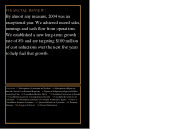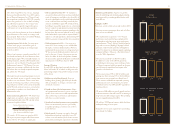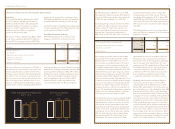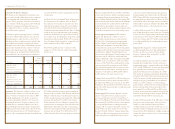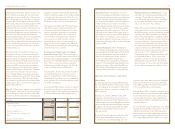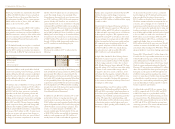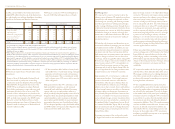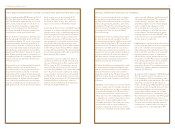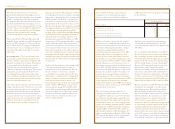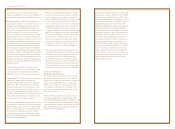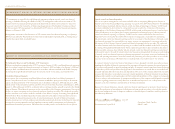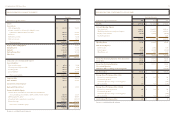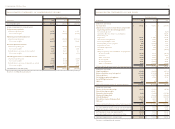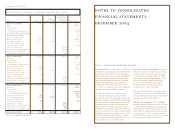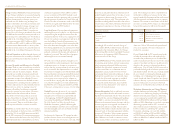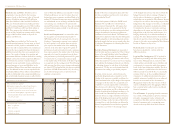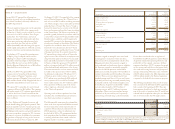North Face 2004 Annual Report Download - page 34
Download and view the complete annual report
Please find page 34 of the 2004 North Face annual report below. You can navigate through the pages in the report by either clicking on the pages listed below, or by using the keyword search tool below to find specific information within the annual report.
63vf corporation 2004 Annual Report
We are currently evaluating FASB Statement No. 123
(R), Share-Based Payment, which was issued in late
2004. This Statement requires that the cost of stock
options, based on the fair value of such options at
the date of grant, be recognized as compensation
expense over the vesting period. This Statement
also changes the method of expense recognition for
our performance-based restricted stock units.
The new Statement, which must be adopted no later
than the beginning of the third quarter of 2005, has
two methods of adoption. VF may elect to recognize
compensation expense for options granted prior to
but not vested as of the date of adoption, in which
case prior periods would remain unchanged and pro
forma disclosures would continue to be provided for
those periods. Alternatively, VF may elect to restate
either all prior periods presented, or all periods since
the beginning of 2005, by recognizing compensation
expense in the amounts previously reported in the
pro forma disclosures.
Management has not yet determined which method
of adoption it will use for the new Statement.
The estimated effect of adopting the new rules for
all unvested stock options and other stock-based
compensation will be to reduce reported earnings per
share by approximately $0.05 for each quarter of 2005
following adoption. In addition, if the first method
above is selected, we would record a noncash charge
at the date of adoption for the cumulative effect of
applying the new rules for all unvested stock options,
which we estimate to be approximately $0.10
per share. Although the new rules will result in
a reduction in future earnings, there will be no
impact on total Common Stockholders’ Equity.
As described in Note A to the Consolidated Financial
Statements, in accordance with applicable accounting
pronouncements to date, compensation expense has
not been recognized for stock options but has been
recorded for other forms of equity compensation.
If compensation expense in 2004 and prior years had
been recognized for stock options based on the fair
value-based method, reported earnings per share
would have been reduced by $0.11 in 2004 and $0.12
in 2003. The pro forma effect in 2004 was slightly
less than 2003 due primarily to the reduced number
of stock options granted in 2004, offset in part by the
higher fair value of those options.
Compensation expense recorded in the financial
statements for performance-based restricted stock
units was $0.06 per share in 2004, compared with
$0.01 per share in 2003. Compensation expense
increased for these performance-based restricted
stock units during 2004 due to (1) a shift in the overall
mix of long-term executive compensation, with an
increased number of restricted stock units granted
in 2004 offset by a reduced number of stock options
granted, (2) the increased price of VF Common Stock
and (3) the high level of performance relative to
targets previously established by the Compensation
Committee of the Board of Directors.
stock-based compensation; change in accounting policy effective in 2005
We have chosen accounting policies that we believe
are appropriate to accurately and fairly report VF’s
operating results and financial position in conformity
with accounting principles generally accepted in the
United States. We apply these accounting policies in a
consistent manner. Our significant accounting policies
are summarized in Note A to the Consolidated
Financial Statements.
The application of these accounting policies requires
that we make estimates and assumptions that affect
the reported amounts of assets, liabilities, revenues and
expenses, and related disclosures. These estimates and
assumptions are based on historical and other factors
believed to be reasonable under the circumstances.
We evaluate these estimates and assumptions on an
ongoing basis and may retain outside consultants to
assist in our evaluation. If actual results ultimately
differ from previous estimates, the revisions are
included in results of operations in the period in
which the actual amounts become known.
We believe the following accounting policies involve
the most significant management judgments and
estimates used in preparation of our Consolidated
Financial Statements or are the most sensitive to
change from outside factors. We have discussed the
application of these critical accounting policies and
estimates with the Audit Committee of our Board
of Directors.
•Inventories – Our inventories are stated at the lower
of cost or market value. Cost includes all material,
labor and overhead costs incurred to manufacture
or purchase the finished goods. We review all of
our inventory each quarter on the basis of indi-
vidual style-size-color stockkeeping units (“SKUs”)
to identify excess or slow moving products, discon-
tinued and to-be-discontinued products, and
off-quality merchandise. This review covers inven-
tory on hand, as well as current production or
purchase commitments. For those units in inven-
tory that are so identified, we estimate their market
value or expected selling price based on historical
and current realization trends. This evaluation,
performed using a systematic and consistent
methodology, requires forecasts of future demand,
market conditions and selling prices. If the
forecasted selling price is less than cost, we
provide an allowance to reflect the lower value
of that inventory. This methodology recognizes
inventory exposures, on an individual SKU basis,
at the time such losses are evident rather than at
the time goods are actually sold.
•Long-lived assets – Our depreciation policies for our
property, plant and equipment and our amortization
policies for our definite-lived intangible assets
reflect judgments on the estimated economic lives
of these assets. We review these assets for possible
impairment whenever events or circumstances
indicate that the carrying amount of an asset may
not be fully recoverable. We measure recoverability
of the carrying value of these assets by comparison
with undiscounted cash flows expected to be
generated by the assets. These evaluations have not
resulted in any significant impairment adjustments
during the past three years.
In connection with our adoption of FASB Statement
No. 142, Goodwill and Other Intangible Assets, as
of the beginning of 2002, we performed a review
of our goodwill for possible impairment. The review
required that we estimate the fair value of our
business units having goodwill. Fair value was based
on the present value of expected future cash flows,
which required judgment and estimation about
future market conditions, future sales and prof-
itability, and a discount rate commensurate with
the risk inherent in each business unit. We engaged
an independent valuation firm to assist us in
determining the fair value of these business units.
The write-down resulting from this review was
recorded as the cumulative effect of a change in
accounting policy as of the beginning of 2002.
critical accounting policies and estimates



